
ABOUT THE ARTISTS
ED BENAVENTE (b. 1960)
 |
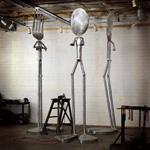 |
|
Tools of Mass Consumption
2005
(Click to enlarge) |
A native of Los Angeles, Ed Benavente has been creating sculpture since 1990. His mastery of working in steel has allowed him to transform the strong durable material into sculptures that express motion, thought, whimsy and humor. Benavente’s works can be viewed literally or explored for deeper meaning. The artist has commented that his sculptures are "icons of the here and now" that illustrate society's attitudes and actions. For a decade, children have enjoyed playing at the feet of Benavente’s 14-foot tall red "hammerhead" sculpture near the sandbox at the Malibu Country Mart. Other works of his can be seen at Wandall Sculpture Garden in Meadowbrook Park, Urbana, Illinois and Pyramid Hill Sculpture Park, Hamilton, Ohio.
KEN BORTOLAZZO (b. 1947)
 |
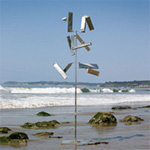 |
|
Mazzo di Fiori, 2005
(Click to enlarge) |
Ken Bortolazzo’s early passion for complex puzzles is evidenced by the interlocking geometric forms of his work. The geometry is a reflection of the order he observed, growing up in Santa Barbara, in the rhythm and sequence of breaking waves, rock formations and plant growth. Bortolazzo creates small, intimate works as well as large monumental sculpture. At his studio, he grinds stainless steel, creating a surface that beautifully reflects light. In his work, there is a dichotomy between the simplicity of the line and the complexity of the lines’ interaction. Bortolazzo’s forms are not intrusive. They fit into the environment, extending it through a silent dialogue that complements the surroundings. Refined and strong, his sculpture invites the eye to explore all sorts of optical possibilities. Bortolazzo’s recent series feature kinetic works that use movement and perforated stainless steel to exploit the dazzling moiré effects caused by optical interference patterns.
MARLENE LOUCHHEIM (b. 1932)
 |
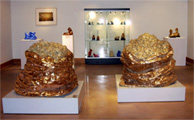 |
|
Full of Nature, 2003
(Click to enlarge) |
A Los Angeles native, Marlene Louchheim has also lived in Japan and on the East Coast of the United States. Throughout her life, she has been a keen observer of human relationships, and she creates her sculptures to explore the subtleties and intricacies of human emotion. In her studios in Los Angeles and Hawaii, Louchheim uses burlap, bronze, aluminum, and copper to create an emotional stage for the natural twists and sensual curves in her material. Her "bags" talk to each other— about love, about distance, about fear and tenderness. Each has its own message and uniqueness, like the differences that exist in the humans who view them. Louchheim’s sculptures range in size from small intimate indoor pieces to giant aluminum and bronze bags. Earlier this year in Palm Desert, California, Louchheim had a 25-year retrospective at the Walter Marks Museum on the campus of the College of the Desert.
GWYNN MURRILL (b. 1942)
 |
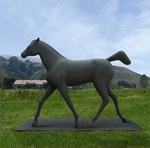 |
|
Horse, 2002
(Click to enlarge) |
Born in Michigan, Gwynn Murrill grew up in California. Although she has created life-size human portraits, she prefers to sculpt animals. Her sculpture has a cool, smooth, simplified spirit. Her figures are both timeless and contemporary. She relies on photographs and memories of the rare glimpses she’s had of her wild subjects. Murrill has always been intrigued by the abstract form of the animals in the Santa Monica hills, where she lives. Murrill uses the abstraction in the movement and the essence of the animal without exactly rendering it. Her earliest subjects—lifesize coyotes, cougars, and other cats—were carved out of large blocks of laminated wood. Since then, she has introduced new elements, testing other media such as marble and bronze. Recently, one of Murrill’s large sculptures was placed in the beautiful sculpture garden of the Norton Simon Museum in Pasadena. Four of her 8-foot-high bronze hawks sit on a 26-story savings-and-loan building in downtown Los Angeles.
BRET PRICE (b. 1950)
 |
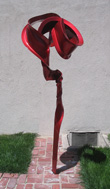 |
|
Red Medley
2001
(Click to enlarge) |
Bret Price graduated from Pomona College in Claremont and furthered his education in Los Angeles at the Otis Art Institute and the California Institute of the Arts. For a decade, he was an assistant professor of art at Chapman University in Orange, California. Since 1979, Price has been bending and twisting steel to make sculpture. He has built heating chambers around large pieces of steel, applying concentrated, intense heat, then manipulating the material to create both his large and small works. The variables of heat intensity, size and shape of the raw material produce a wide range of results—from the quiet simplicity of a single pipe bend to the rhythmic complexity that emerges from folding a large section of structural steel. Price’s works are in many public collections, including the Pepsico Sculpture Garden in New York and the Orange County Museum of Art in California.
EDOARDO VILLA (b. 1920)
One of South Africa’s foremost sculptors, Edoardo Villa was born in Italy and studied sculpture in Milan. After his release as a prisoner of war during World War II, he remained in South Africa to pursue his career as a sculptor. On five occasions, Villa was chosen to represent South Africa at the Venice Biennale. In 1995, in celebration of the artist’s 80th birthday, the Edoardo Villa Museum was officially opened at the University of Pretoria, South Africa. Aside from working masterfully in steel, he has created large bronze works that would seem to be abstract, yet are basically figurative in concept. The universality of humankind is a theme that dominates his sculpture.
|
 |
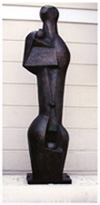 |
|
Sculpture for a Garden in Durban
1970
(Click to enlarge) |
|
LEW WATANABE (b. 1933)
 |
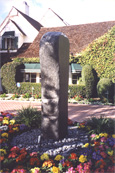 |
|
Quasimodo
(Click to enlarge) |
The working of stone links Lew Watanabe to an old tradition. He has created water sculpture and weeping water walls, as well as monoliths and benches. In this age of stress, he has created settings for meditation and reflection, serenity and peace. Watanabe has public works in the city of Sierra Madre, where he has lived and worked for decades, as well as in Descanso Gardens in La Canada-Flintridge and in the garden of the Frederick Weisman Museum on the Pepperdine campus in Malibu. Usually quiet and humble, Watanabe has put himself in the spotlight in the last two years with his unrelenting perseverance, courage and optimism in recovering from a freak accident he suffered in 2003 while installing art. From a prognosis of quadriplegic, Lew has surpassed every medical expectation and recovered to a remarkable extent. With the help of 200 friends in the art community who provided the funds for daily physical therapy, acupuncture with electrical stimulation and deep tissue massage, Watanabe has regained range of-motion and some fine muscle skills and is back to work on landscape projects.
|